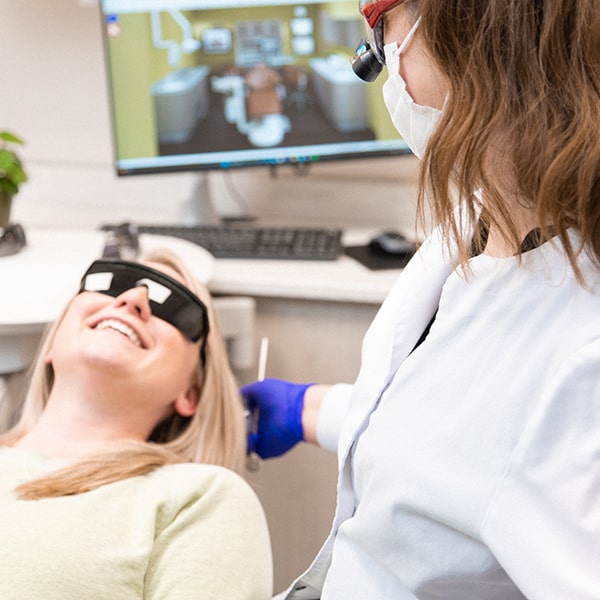Gum Disease
Gum Disease Treatment in Stratford, CT
Gum disease is one of the most serious conditions that one will ever have to encounter, yet timely prevention or intervention can preserve your dental health and save you from any long-term repercussions. This is where Hawley Lane Dental comes in. As a highly skilled gum disease specialist near you in Stratford, we are here to help! Our office is conveniently situated just east of CT-8 and Merritt Parkway, serving residents of Stratford, Trumbull, and Bridgeport, Connecticut.
Gingivitis and Periodontal disease are easily detectable through the processes of periodontal charting. Periodontal charting is done by a dentist, periodontist, or dental hygienist. Periodontal charting primarily consists of probing (measuring) how tightly the gums are attached to the teeth. Healthy gums will have a measurement of 1-3 millimeters. Readings of 4 millimeters or higher may indicate the presence of periodontal disease. During periodontal charting, gum recession is noted, as well as inflammation, tooth mobility (loose teeth), bleeding, or puss.

What Are the Risk Factors for Gum Disease?
Your dentist or hygienist will also discuss your risk factors. These may include:
-
Tobacco use
-
Long periods between dental visits
-
Family history
-
Medications
-
Stress
-
Overall health
-
Age
-
Lack of proper home care (flossing and brushing)

What Are the Stages of Gum Disease?
There are different stages of periodontal disease, and your recommended treatment may vary based on the stage of the periodontal disease diagnosed by your dental provider.
-
Gingivitis
This is the beginning of periodontal disease and the only stage that can be reversed. It is treated by both dental cleanings and routine at-home care. Signs of gingivitis may include slight sensitivity or soreness as well as bleeding when brushing and flossing. It is important to note that even gums that measure in the “healthy range” of 1-3 millimeters may still show signs of gingivitis. Your diagnosis is not based solely on numbers. The amount of plaque or tartar, bleeding, and the visual appearance of the gums also contribute to your diagnosis.
-
Periodontal Disease (Periodontitis)
This is the progression of gingivitis. The bacteria that remain in the mouth and on the surface of the teeth have migrated below the gum and have begun to destroy the tissue and bone that support the teeth. The gums separate from the teeth, and bone loss may begin. Periodontal charting may show measurements of 4 millimeters or higher. Bleeding and recession may also be present. Because bacteria are present below the gum line, a “regular” dental cleaning (prophylaxis) that cleans the surface of the teeth is not enough to treat the disease. Scaling and root planing (deep cleaning) may be recommended by your provider to remove the bacteria below the gums. Antibiotics may also be used in combination with scaling and root planning.
More advanced or aggressive forms of periodontal disease are the most difficult to treat. At this stage, the signs and symptoms are easily noticed. These include bleeding or pus, difficulty or pain when eating, tooth mobility, gum recession, and severe bone loss visible on an X-ray. Your provider may recommend gum surgery to try to preserve your teeth. Teeth that may not respond to treatment may be recommended for extraction.
Studies have shown that up to 80% of the population has some form of periodontal disease present at any given time. The only way to prevent or treat the disease is to see your dental provider for proper diagnosis and treatment.
Gum Disease PreventionThrough Early Screening
How Gum Disease Can be a Threat to Your Oral Health
Gum disease is one of the most common issues we encounter in our practice, yet many patients don’t realize they have it. In fact, about 80% of the patients we see show some form of gum disease, from mild gingivitis to more severe periodontal disease. The challenge? Most patients don’t recognize the early signs, as gum disease is often painless in its initial stages. By the time symptoms like loose teeth or gum recession appear, the damage is much harder to reverse. It’s important to seek gum recession treatment as soon as possible to prevent further damage. Early intervention can help protect your oral health and avoid more complex treatments down the road.
Why Early Screening is Essential
The key to preventing gum disease from advancing is early detection. Unfortunately, many dental offices don’t prioritize comprehensive gum screenings, especially older practices. At our office, we screen every patient, every time they visit. This routine approach allows us to:
- Establish a baseline for new patients.
- Monitor subtle changes in gum health over time.
- Catch gum disease in its earliest, most treatable stages.
By diagnosing gum issues early, we can intervene with less invasive and more cost-effective treatments, saving patients from extensive damage and costly procedures down the road.
The Early Signs of Gum Disease We Look For
During a gum screening, we thoroughly assess your gums for any signs of gum disease, even if you haven’t noticed noticeable symptoms. Many people may not realize that early gum disease can develop without obvious signs, which is why routine screenings are so important. The earliest indicators we check for include:
- Puffy, red gums: Inflammation in your gums, causing them to become swollen and red, is often the first sign of trouble. This can occur when your gums are irritated by plaque buildup or tartar. If you notice that your gums appear puffy, this could indicate early gum disease or gingivitis, which can be treated if caught early.
- Bleeding gums: Healthy gums don’t bleed when you brush or floss. If you notice bleeding during these activities, it’s a clear sign that your gums are inflamed. This is often a symptom of gingivitis or periodontal disease, both of which can lead to more serious oral health issues if left untreated.
- Plaque buildup: Plaque is a sticky film of bacteria that forms on your teeth. When plaque isn’t regularly removed through proper oral hygiene, it hardens into tartar, which irritates the gums. Plaque buildup is a major factor that can lead to gum infection, receding gums, and even bone loss if not addressed.
Even if you don’t exhibit these obvious symptoms, we still perform regular gum disease screenings to ensure that no hidden issues are developing. Many times, patients are unaware of the early stages of gum disease until we point it out. As gum disease progresses, it can cause pain, bad breath, and even result in tooth loss in severe cases.
By the time patients notice sensitivity to hot or cold foods, or pain when chewing, the disease may have already advanced. That’s why early intervention is essential. We strive to catch gum disease early, so you can maintain healthy gums and avoid serious complications like receding gums, bone loss, and tooth loss.
Regular check-ups are essential for preventing gum disease, even when you feel your gums are in good condition. Good oral hygiene and professional cleaning can remove tartar buildup, reduce inflammation, and improve overall oral health. If gum disease is detected, we can offer treatments to help restore gum health and prevent further damage.
Advanced Gum Disease Symptoms
If gum disease progresses, the symptoms become more noticeable and severe. As gum disease advances, common signs and symptoms we often observe include:
- Gum recession: The gums begin to pull away from the teeth, exposing more of the tooth root. Treatment for gum recession may include deep cleanings to control the infection and gum grafting procedures to restore lost gum tissue and protect the exposed roots. Receding gums can also increase sensitivity to hot and cold, making it uncomfortable to eat or drink certain foods and beverages.
- Loose teeth: Patients may notice their teeth shifting or experience difficulty chewing certain foods due to looseness. As the disease progresses, the structures that hold the teeth in place weaken, making teeth more mobile and potentially causing a misalignment of the bite. This can lead to discomfort and additional oral health problems if left untreated.
- Bone loss: X-rays can reveal the deterioration of the bone supporting the teeth, a common sign of advanced gum disease. Bone loss can lead to significant issues with tooth stability and may require interventions like bone grafting in certain cases to restore lost tissue and prevent further complications.
- Persistent bad breath: Bad breath, or halitosis, is often a result of the bacteria present in the gums and mouth due to untreated gum disease. The bacteria produce sulfur compounds, causing foul-smelling breath that can persist even with regular brushing and flossing.
At this stage, patients may need more intensive treatments, such as deep cleanings, gum surgery, or, in severe cases, extractions. Early intervention is key to preventing the progression of gum disease and preserving both oral health and the overall well-being of the patient. If left untreated, advanced gum disease can lead to tooth loss, increased risk of infection, and other systemic health issues such as heart disease or diabetes complications.
Gum Recession Treatment Near You
Gum recession treatment focuses on addressing the underlying causes, managing symptoms, preventing further damage, and restoring lost gum tissue when necessary. While receding gums cannot regenerate naturally, a proactive at-home care routine can help slow the progression and ease discomfort. Key steps include brushing and flossing daily with a soft-bristled toothbrush, using antimicrobial mouthwash to reduce plaque, avoiding tobacco use, and applying desensitizing toothpaste to reduce sensitivity. Additionally, maintaining proper dental hygiene can prevent the buildup of harmful bacteria that contribute to gum recession.
For individuals with advanced gum recession, in-office treatments may be required to restore gum health. These treatments can include the application of topical antibiotics to fight infection, dental bonding to cover exposed roots, orthodontic adjustments to correct misaligned teeth contributing to the recession, or gum graft surgery. If you’re considering dental bonding in Stratford, this treatment can also help protect exposed roots and improve overall comfort. Gum grafting, performed by a skilled periodontist, is a minimally invasive procedure that involves taking tissue from the roof of your mouth or a donor source to replace lost gum tissue. This helps protect exposed tooth roots, reduce sensitivity, and improve the overall appearance of your gums.
In some cases, regenerative treatments, such as tissue-stimulating proteins or lasers, may be used to encourage the growth of new gum tissue. These advanced techniques aim to not only halt the progression of gum recession but also regenerate some of the lost tissue to provide long-term protection for the teeth. While surgery is often necessary for severe cases, it’s important to remember that early intervention and ongoing care can significantly improve gum health and prevent the need for more invasive treatments down the line.
Regular checkups with a dentist or periodontist are essential for monitoring gum health and adjusting treatment plans as needed. A personalized approach, addressing both the symptoms and causes of gum recession, offers the best chance for restoring gum health and preventing further complications. Through a combination of professional treatments and diligent home care, gum recession can be effectively managed, enhancing both oral health and overall quality of life.
How We Screen for Gum Disease in Every Patient
Our gum screenings are thorough and systematic. For every patient, we use a small ruler-like instrument to measure the space between the teeth and gums. This “pocket depth” measurement helps us determine the health of the gum tissue:
- Healthy gums: Pockets of 1–3 millimeters are considered normal.
- Signs of gum disease: Pockets greater than 3 millimeters indicate that the gums are starting to separate from the teeth, a sign of disease progression.
We measure six points on every tooth, recording these findings in the patient’s chart. This allows us to monitor changes over time and address potential problem areas before they worsen.
Regular Checkups for Lifelong Gum Health
For new patients, we establish a detailed baseline during their first visit. This includes measuring their gum health and documenting any areas of concern. At subsequent visits, we focus on problem areas while rechecking their overall gum health. Even patients with no symptoms or complaints benefit from routine screenings, as gum disease can remain undetected without professional evaluation.
For patients at higher risk of gum disease—such as those with diabetes, dry mouth, or poor oral hygiene—we may recommend more frequent cleanings and checkups. Our goal is to catch issues early and help patients maintain optimal oral health.
Early Gum Disease Treatment for Better Outcomes
When gum disease is identified early, the treatment options are often straightforward and minimally invasive. Early intervention is crucial to prevent the disease from progressing to more severe stages. Common gum disease treatments include:
- Professional cleanings: This procedure removes plaque and tartar buildup from the surface of the teeth and along the gumline. Regular professional cleanings can resolve mild gingivitis and prevent it from advancing to more severe forms of gum disease. These cleanings are essential in maintaining optimal oral health and preventing gum infections.
- Scaling and root planing: This deeper cleaning procedure is used to treat moderate to severe gum disease, targeting the root surfaces of the teeth. Scaling involves removing plaque and tartar from above and below the gumline, while root planing smooths the roots of the teeth to help the gums reattach to the teeth and prevent future infections. This technique helps to address pockets of bacteria and is effective in reducing inflammation and bleeding.
- At-home care recommendations: Improving daily oral hygiene habits is crucial in managing gum disease. Brushing at least twice a day with a fluoride toothpaste, flossing daily, and using mouthwash can help remove plaque and bacteria that contribute to gum disease. Additionally, adopting a healthy diet that supports oral health, such as reducing sugar intake, can play a vital role in stopping gum disease in its tracks. A consistent oral care routine helps maintain gum health and prevents the recurrence of gum disease.
For patients with more advanced cases of gum disease, we may recommend consulting a periodontist, a dental specialist in treating the structures around the teeth. The periodontist can provide a comprehensive evaluation and recommend additional treatment options. These may include the use of antibiotics to target bacterial infections or surgical interventions such as gum grafts or flap surgery to repair damaged gums and restore oral health. Surgical options may be required for advanced periodontitis, which cannot be managed through non-invasive methods alone.
In cases where gum disease has caused significant tooth loss or bone deterioration, more extensive treatments may be needed to rebuild the gums and bone. This could include bone grafting, dental implants, or other restorative procedures to ensure that the patient’s oral health is fully restored.
Prevention is key when it comes to gum disease, and regular dental checkups are essential for detecting any early signs of gum disease. These checkups allow for timely intervention, helping to avoid more invasive treatments and ensuring long-term gum health. Additionally, staying informed about the causes and symptoms of gum disease—such as swollen, bleeding gums, persistent bad breath, and tooth sensitivity—empowers patients to take proactive steps in managing their oral health.
By addressing gum disease early and following a comprehensive treatment plan, patients can maintain healthy gums and prevent complications associated with advanced gum disease.
Educating Patients About Gum Health
One of the most difficult conversations we have is with patients who come in after years of neglect or inadequate dental care. These patients often didn’t realize their gum health was deteriorating because previous dental offices failed to screen for it. By showing them detailed measurements, X-rays, and comparisons to healthy gums, we help them understand their condition and the steps they can take to improve it.
Why Our Approach is Different
What sets our practice apart is our commitment to screening every patient, every time. Many offices don’t measure gum health routinely, which can lead to undiagnosed cases of gum disease. Our proactive approach ensures that no patient leaves our office unaware of their gum health. We prioritize early detection and patient education because we believe prevention is the best treatment.
Take Control of Your Gum Health Today
Gum disease doesn’t have to progress to the point where it impacts your smile or overall health. With regular screenings and early intervention, you can keep your gums healthy and your teeth strong for a lifetime. Schedule a visit with a dentist near you to learn more about how our screenings can help protect your smile.
-
Monday - 9:00am–5:00pm
-
Tuesday - 8:00am–5:00pm
-
Wednesday - 8:00am–5:00pm
-
Thursday - 8:00am–5:00pm
-
Friday - 8:00am–5:00pm



